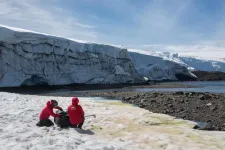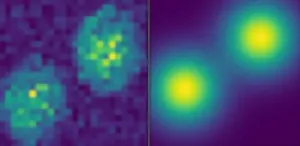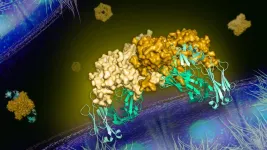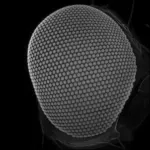Red and green snow algae increase snowmelt in the Antarctic Peninsula
2021-01-13
(Press-News.org) Red and green algae that grow on snow in the Antarctic Peninsula (AP) cause significant extra snowmelt on par with melt from dust on snow in the Rocky Mountains, according to a first-of-its-kind scientific research study led by Alia Khan, affiliate research scientist at the National Snow and Ice Data Center (NSIDC) and assistant professor at Western Washington University. Algal blooms are likely to increase in Antarctica as the planet continues to warm, which will further exacerbate seasonal snowmelt and contribute to the expansion of ice-free areas in the AP region. This could have serious impacts on regional climate, snow and ice melt, freshwater availability and ecosystems, yet is not accounted for in current global climate models. Results of the research were published on January 13, 2021, in the European Geosciences Union's The Cryosphere.
"Warming along the Antarctic Peninsula is causing drastic changes in snow and ice melt, as well as ecosystem responses," said Khan. "We are seeing these algae blooms spread across wide areas along the coast. The blooms can be so intense and dark, like wearing a dark T-shirt on a sunny day, that they warm up the surface and cause more melting. The warming is likely expanding and strengthening the snow algae bloom season, which could continue to increase in this region of Antarctica as the climate continues to warm."
The researchers investigated the impacts of red and green algae on albedo, which is how much light the surface of the snow reflects back to space, and radiative forcing, which is how much energy the surface absorbs. Darker surfaces decrease albedo and increase radiative forcing, and positive radiative forcing causes the planet to warm. This is the first time that radiative forcing effects from algae have been estimated in the AP region. The scientists conducted this research by taking ground-based spectral albedo measurements of red and green snow algae at three sites in January 2018 and then modeled the radiative forcing using historical multi-year measurements of solar radiation at Palmer Station in Antarctica. Two of the ground sites were on King George Island, north of Palmer Station, and one was on Nelson Island. Because algal blooms are linked to animal waste, which produces the nutrients that the algae need to grow, the researchers chose sites that seals, penguins and other birds frequent.
When compared with clean snow, the scientists found that green algae patches reduce snow albedo by 40 percent, and red algae patches reduce albedo by 20 percent. Green snow algae contain more chlorophyll than red snow algae and therefore absorb more solar radiation, reducing albedo by a greater amount for the same concentration of algae in the snow. As a result, radiative forcing averages are twice as high for green patches compared with red patches. During peak growing season, in austral summer, the increase in radiative forcing is about 26 watts per square meter, and about 13 watts per square meters for red algae. These amounts of radiative forcing are comparable to those caused by dust on snow in the mid-latitudes, such as in the Rocky Mountains, which advances snowmelt there. In the AP, algal blooms result in about 3,700 cubic meters, or over a million gallons of additional snow melt per year.
"Antarctica is already an incredibly beautiful place, and snow algae blooms add an extra artistic dimension," said Ted Scambos, a polar researcher at the Cooperative Institute for Research in the Environmental Sciences (CIRES) at the University of Colorado Boulder and co-author of the study. "But like so many natural systems, the change in climate is pushing things to new extremes, with some unwanted consequences. We're seeing that these new darker and more widespread blooms are having a knock-on effect of accelerating melting, a feedback that makes the ice retreat a little faster."
The results of this research show that snow algae play a significant role in snowmelt in the AP regions where they occur, and should be accounted for in future estimates of ice-free expansion in the AP region. Future research will focus on a wider mapping the spread of algae blooms, and on the climate events that create the most intense blooms.
INFORMATION:
[Attachments] See images for this press release:

ELSE PRESS RELEASES FROM THIS DATE:
2021-01-13
Scientists claim to have found the 'missing link' in the process that leads to an ice age on Earth.
Melting icebergs in the Antarctic are the key, say the team from Cardiff University, triggering a series of chain reactions that plunges Earth into a prolonged period of cold temperatures.
The findings have been published today in Nature from an international consortium of scientists from universities around the world.
It has long been known that ice age cycles are paced by periodic changes to Earth's orbit of the sun, which subsequently changes the amount of solar radiation that reaches the Earth's surface.
However, ...
2021-01-13
KU Leuven researchers have identified the biological mechanism that explains why some people experience abdominal pain when they eat certain foods. The finding paves the way for more efficient treatment of irritable bowel syndrome and other food intolerances. The study, carried out in mice and humans, was published in Nature.
Up to 20% of the world's population suffers from the irritable bowel syndrome (IBS), which causes stomach pain or severe discomfort after eating. This affects their quality of life. Gluten-free and other diets can provide some relief, but why this works is a mystery, since the patients are not allergic to the foods in question, nor do they ...
2021-01-13
Researchers have shown that the link between physical and mental illness is closer than previously thought. Certain changes in physical health, which are detectable in childhood, are linked with the development of mental illness in adulthood.
The researchers, led by the University of Cambridge, used a sample of over 10,000 people to study how insulin levels and body mass index (BMI) in childhood may be linked with depression and psychosis in young adulthood.
They found that persistently high insulin levels from mid-childhood were linked with a higher chance of developing psychosis in adulthood. In addition, they found that an increase in BMI around the onset of puberty, was linked with a higher chance of developing depression in adulthood, ...
2021-01-13
Since the earliest microscopes, scientists have been on a quest to build instruments with finer and finer resolution to image a cell's proteins - the tiny machines that keep cells, and us, running. But to succeed, they need to overcome the diffraction limit, a fundamental property of light that long prevented optical microscopes from bringing into focus anything smaller than half the wavelength of visible light (around 200 nanometers or billionths of a meter) - far too big to explore many of the inner-workings of a cell.
For over a century, scientists have experimented with different approaches - from intensive calculations to special lasers and microscopes - to resolve cellular features at ever smaller scales. And ...
2021-01-13
TORONTO, Jan. 13, 2021 - Close to 5,700 lakes in the Northern Hemisphere may permanently lose ice cover this century, 179 of them in the next decade, at current greenhouse gas emissions, despite a possible polar vortex this year, researchers at York University have found.
Those lakes include large bays in some of the deepest of the Great Lakes, such as Lake Superior and Lake Michigan, which could permanently become ice free by 2055 if nothing is done to curb greenhouse gas emissions or by 2085 with moderate changes.
Many of these lakes that are ...
2021-01-13
SILVER SPRING, Md.--A new study confirms that treatment with Bimagrumab, an antibody that blocks activin type II receptors and stimulates skeletal muscle growth, is safe and effective for treating excess adiposity and metabolic disturbances of adult patients with obesity and type 2 diabetes.
"These exciting results suggest that there may be a novel mechanism for achieving weight loss with a profound loss of body fat and an increase in lean mass, along with other metabolic benefits," said Steve Heymsfield, MD, FTOS, past president of The Obesity Society and corresponding author of the study. Heymsfield is professor and director of the Metabolism and Body Composition Laboratory at the Pennington Biomedical Research Center in Baton Rouge, La.
A ...
2021-01-13
LAWRENCE -- Parents around the world have long told us that breakfast is the most important meal of the day. Soon, basketball coaches may join them.
Researchers at the University of Kansas have published a study showing that eating breakfast can improve a basketball player's shooting performance, sometimes by significant margins. The study, along with one showing that lower body strength and power can predict professional basketball potential, is part of a larger body of work to better understand the science of what makes an elite athlete.
Breakfast and better basketball shooting
Dimitrije Cabarkapa left his native Novi Sad, Serbia, to play basketball at James Madison University. Never a fan of 6 a.m. workouts, he was discussing ...
2021-01-13
A team of researchers led by the University of California, Berkeley and the University of Michigan has discovered an antibody that blocks the spread within the body of the dengue virus, a mosquito-borne pathogen that infects between 50 and 100 million people a year. The virus causes what is known as dengue fever, symptoms of which include fever, vomiting and muscle aches, and can lead to more serious illnesses, and even death.
"Protein structures determined at the APS have played a critical role in the development of drugs and vaccines for several diseases, and these new results are key to the development of a potentially effective treatment against flaviviruses." -- Bob Fischetti, group leader with Argonne's X-ray Sciences Division and life sciences ...
2021-01-13
The fascinating compound eyes of insects consist of hundreds of individual eyes known as "facets". In the course of evolution, an enormous variety of eye sizes and shapes has emerged, often representing adaptations to different environmental conditions. Scientists, led by an Emmy Noether research group at the University of Göttingen, together with scientists from the Andalusian Centre for Developmental Biology (CABD) in Seville, have now shown that these differences can be caused by very different changes in the genome of fruit flies. The study was published ...
2021-01-13
HOUSTON - (Jan. 13, 2021) - Pyrolyzed plastic ash is worthless, but perhaps not for long.
Rice University scientists have turned their attention to Joule heating of the material, a byproduct of plastic recycling processes. A strong jolt of energy flashes it into graphene.
The technique by the lab of Rice chemist James Tour produces turbostratic graphene flakes that can be directly added to other substances like films of polyvinyl alcohol (PVA) that better resist water in packaging and cement paste and concrete, dramatically increasing their compressive strength. ...
LAST 30 PRESS RELEASES:
[Press-News.org] Red and green snow algae increase snowmelt in the Antarctic Peninsula






